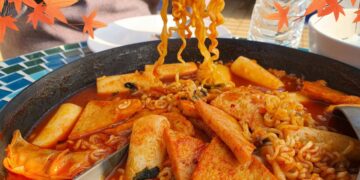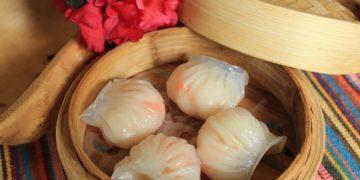Traveling to Korea and worried about Korean food menus? Learn common Korean food menu dishes translation to navigate restaurants like a pro!
Korean cuisine is famous for its rich flavors, diverse ingredients, and vibrant culinary traditions. However, for those unfamiliar with the language and cultural nuances, navigating a Korean food menu can be a daunting task. And if you are a first time tourist to South Korea, it can be super difficult to identify food items on menu.
In this guide, we’ll unravel the mysteries of Korean menus, helping you understand unfamiliar dishes and enabling you to embark on a flavorful journey through Korean cuisine.
Understanding the Basics
Before diving into translation of specific dishes and Korean food menu sections, it’s essential to familiarize yourself with some fundamental components of Korean food menus:
Korean Script
Korean menus are typically written in Hangul, the Korean alphabet. Learning to recognize basic Hangul characters can greatly aid in deciphering menu items.
Categorization
Korean menus often categorize dishes according to their main ingredients or cooking methods. Common categories include soups (guk/국), stews (jjigae/찌개), rice dishes (bap/밥), noodles (guksu/국수), and side dishes (banchan/반찬).
Descriptions
Korean menu items are often described using adjectives that highlight key flavors, cooking methods, or ingredients. Understanding these descriptors can provide valuable insights into what to expect from a dish.
Menu Options for Mains
Look for keywords that indicate the primary ingredient of a dish. For example, “samgyeopsal” (삼겹살) refers to grilled pork belly, while “bibimbap” (비빔밥) denotes a mixed rice dish with assorted vegetables and meat. Korean menu items often include descriptive adjectives that convey specific flavors. Terms like “spicy” (매운), “sweet” (달콤한), “savory” (고소한), and “sour” (시원한) can give you clues about a dish’s taste profile.
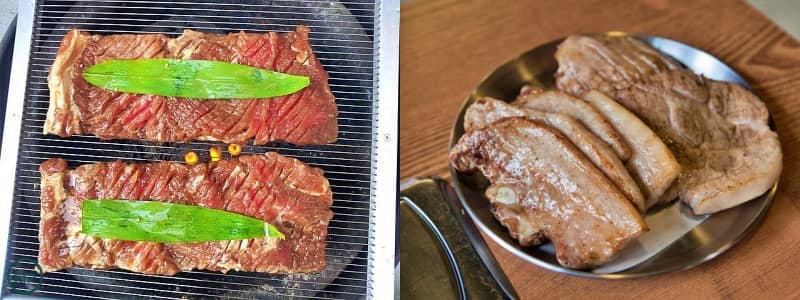
| Korean | Pronunciation | English |
|---|---|---|
| 된장찌개 | Dwen-jang-jji-gae | Miso soup |
| 김치찌개 | Kim-chi-jji-gae | Kimchi pot |
| 부대찌개 | Bu-dae-jji-gae | Army pot (Spicy ham and sausage) |
| 청국장 | Cheong-guk-jang | Fast-fermented bean paste |
| 쫄면 | Jjol-myeon | Spicy cold chewy noodles |
| 해물탕 | Hae-mul-tang | Seafood soup |
| 덮밥 | Deop-bap | Rice with toppings |
| 국물/탕 | Guk-mul/Tang | Soup |
| 비빔밥 | Bibim-bap | Bibimbap |
| 냉면 | Naeng-myeon | Cold noodle soup |
| 짜장면 | Jjajang-myeon | Fried noodles |
| 볶음밥 | Bokkeum-bap | Fried rice |
| 우동 | U-dong | Udon |
| 육개장 | Yukgae-jang | Spicy beef soup |
| 갈비탕 | Galbi-tang | Ribs soup |
| 설렁탕 | Seolleong-tang | White beef broth |
| 곰탕 | Gom-tang | Beef bone soup |
| 갈비찜 | Galbi-jjim | Stewed ribs |
| 콩국수 | Kong-guk-su | Bean juice noodles |
| 칼국수 | Kal-guksu | Noodle soup |
| 수제비 | Suje-bi | Clear soup with dumplings |
| 삼계탕 | Samgyetang | Chicken soup |
| 제육볶음 | Jeyuk-bokkeum | Spicy fried pork |
| 보쌈/수육 | Bossam/Suyuk | Boiled beef or pork slices |
| 순대국밥 | Sundae-gukbap | Blood sausage soup rice |
| 국밥 | Gukbap | Soup rice (rice in soup) |
| 쭈꾸미 | Jjukkumi | Spicy fried octopus |
| 불고기 | Bulgogi | Bulgogi (roast beef) |
| 떡갈비 | Tteokgalbi | Roast beef patties |
| 육회 | Yukhoe | Raw beef |
| 돈까스 | Donkatsu | Tonkatsu (fried pork chops) |
| 족발 | Jokbal | Pig’s feet |
| 김치 | Kimchi | Kimchi (pickled cabbage) |
| 오리지널치킨 | O-ri-ji-neol chi-kin | Original fried chicken |
| 양념치킨 | Yang-nyeom chi-kin | Sauced fried chicken |
| 간장치킨 | Ganjang chi-kin | Soy sauce fried chicken |
| 순살치킨 | Sunsal chi-kin | Boneless fried chicken |
| 찜닭 | Jjim-dak | Stewed chicken |
| 만두 | Mandu | Dumplings |
| 떡만두 | Tteok-mandu | Rice cake dumplings |
| 라면 | Ramyeon | Ramen |
| 감자탕 | Gamjatang | Potato ribs soup |
| 뼈다귀해장국 | Beodeogwi-haejangguk | Pork bone sobering soup |
Extended Menu Options
Many Korean dishes come with accompanying side dishes or condiments known as “banchan.” These may include kimchi (fermented vegetables), pickled radishes, or seasoned greens. Pay attention to these additions, as they can enhance the overall dining experience.
| Korean | Pronounciation | English |
|---|---|---|
| 김치전 | Gimchi-jeon | Kimchi pancakes |
| 파전 | Pa-jeon | Pancakes |
| 해물파전 | Haemul-pajeon | Seafood pancakes |
| 감자전 | Gamja-jeon | Potato pancakes |
| 김치찜 | Gimchi-jjim | Stewed kimchi |
| 비빔밀면 | Bibim-milmyeon | Cold wheat noodles |
| 모래주머니 | Moraeh-jumeoni | Fried chicken chop |
| 고등어구이 | Godeungeo-gui | Grilled fish |
| 조개구이 | Jogae-gui | Grilled shell fish |
| (물)회 | (Mul)hoe | (Water mix) sashimi |
| 빈대떡 | Bindaetteok | Mung bean pancakes |
| 잡채 | Japchae | Stir-fried glass noodles |
Korean Barbecue Options
K-BBQ is something that you must try! You can check out guide on meat cuts for a great barbecuing experience.
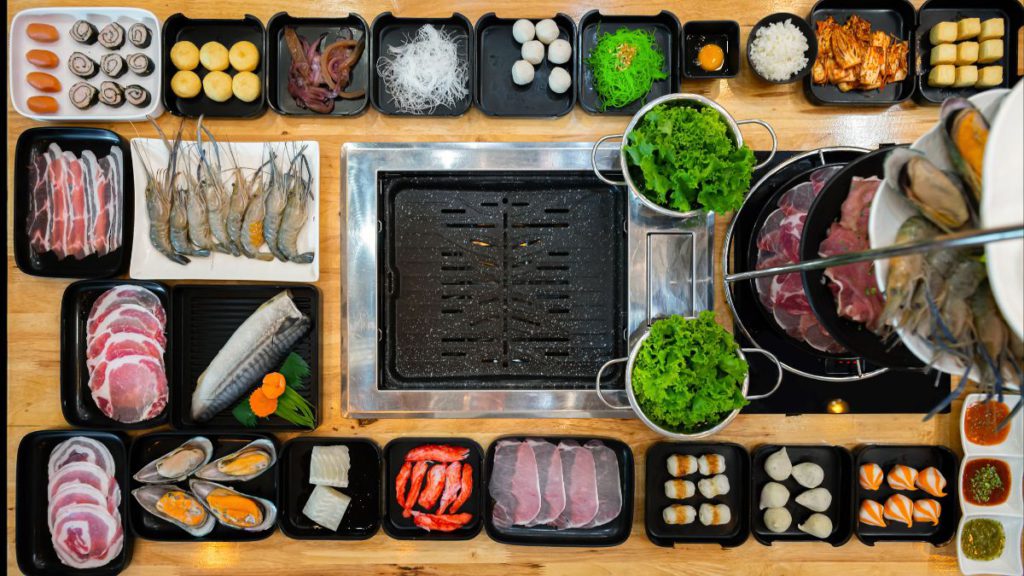
| Korean | Pronunciation | English |
|---|---|---|
| 삼겹살 | Samgyeopsal | Pork belly |
| 목살 | Moksam | Pork neck |
| 항정살 | Hangjeongsal | Pork shoulder |
| 등심 | Deungsim | Beef tenderloin |
| 한우 | Hanwoo | Korean beef |
| 곱창 | Gopchang | Small intestine |
| 돼지막창 | Dwaejimakchang | Pig intestine |
| 소막창 | Somakchang | Beef intestine |
| 껍데기 | Ggeodegi | Pork skin |
| 돼지갈비 | Dwaejigalbi | Pork ribs |
| 닭갈비 | Dakgalbi | Chicken ribs |
| 소갈비살 | Sogalbisal | Beef ribs |
| 가브리살 | Gabrisal | Pork cheek meat |
| 차돌박이 | Chadolbagi | Beef brisket |
| 안심 | Ansim | Beef tenderloin |
| 살치살 | Salchisal | Chuck flap tail |
Conventional Snacks
Korean street food is legendary, but those menus can be as mysterious as ancient scrolls! Worry not – here are some of the sweet, spicy, and other snacks!
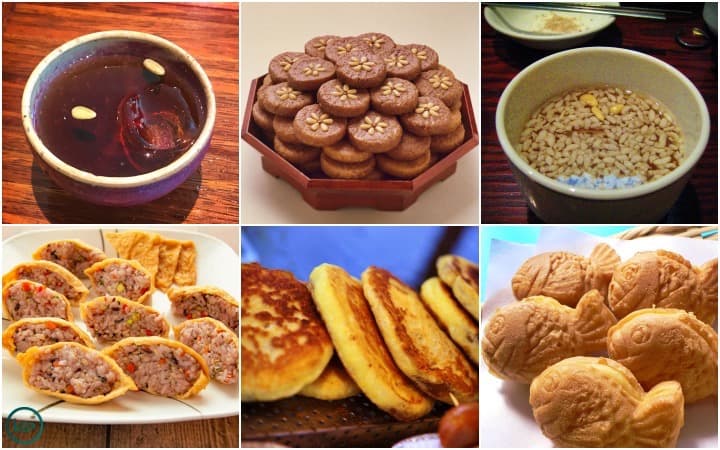
| Korean | Pronunciation | English |
|---|---|---|
| 떡볶이 | Tteokbokki | Spicy rice cake |
| 치즈 | Cheese | Cheese |
| 오징어 | Ojingeo | Squid |
| 순대 | Sundae | Blood sausage |
| 야채 | Yachae | Vegetables |
| 튀김 | Twigim | Fries |
| 고구마 | Goguma | Sweet potato |
| 김말이 | Kim Mari | Seaweed rolls |
| 새우 | Saewoo | Shrimp |
| 김밥 | Gimbap | Gimbap (Korean seaweed rolls) |
| 만두 | Mandu | Dumplings |
| 오뎅 | Odeng | Fish cake |
| 핫도그 | Hatdog | Hot dog |
| 붕어빵 | Bungeo Bbang | Taiyaki |
| 떡꼬치 | Tteok Kkochi | Rice cake skewers |
| 닭강정 | Dak Gangjeong | Fried chicken |
| 호떡 | Hotteok | Sugar cake |
Beverages

| Korean | Pronunciation | English |
|---|---|---|
| 소주 | Soju | Soju |
| 맥주 | Maekju | Beer |
| 카스 | Kaseu | CASS (beer) |
| 하이트 | Haiteu | HITE beer) |
| 처음처럼 | Cheoeum Cheoreom | Like the First Time (soju) |
| 참이슬/후레쉬 | Cham Iseul/Hureushi | Cham Iseul/Fresh (soju) |
| 청하 | Cheongha | Cheongha (soju) |
| 자몽 | Jamong | Grapefruit (soju) |
| 청포도 | Cheongpodo | Green grape (soju) |
| 순하리 | Sunhari | Soonhari (soju) |
| 사과 | Sagwa | Apple (soju) |
| 막걸리 | Makgeolli | Makgeoli (rice wine) |
| 동동주 | Dongdongju | Dong dong ju, or Winter wine |
| 사이다 | Saida | Sprite |
| 콜라 | Kolla | Cola |
Wrapping up
Deciphering a Korean food menu may initially seem challenging, but with a basic understanding of Korean script, culinary terminology, and translation apps, you can confidently explore the diverse world of Korean cuisine. By embracing new flavors and culinary experiences, you’ll embark on a gastronomic adventure that celebrates the richness and diversity of Korean food culture.
Related Posts
5,784 total views, 4 views today


